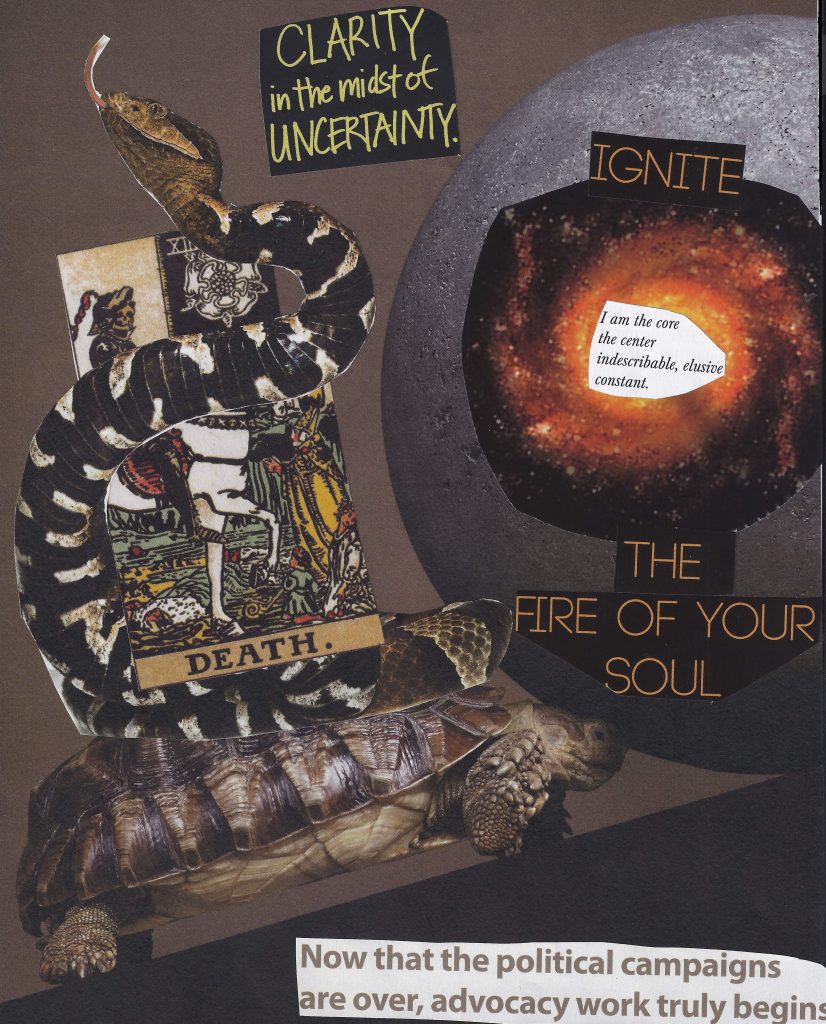In my last post, I discussed propaganda as a tool of control and subversion, and observed that the cultural climate has shifted in such a way that it behooves us to engage consciously with the strategies and consequences of it. Instead of bemoaning propaganda or relegating it to one “side,” it seems to me wisest to acknowledge that it exists, it is effective, and it is widely employed.
What to watch for is whether propaganda leads us toward personal and collective danger. The information we take in influences the mind, the heart, the body, and then our actions. Thinking about things that terrify me, I feel fear in my body, and I respond fearfully to otherwise innocuous things around me. When I can calm and defuse that emotional reaction within me, however, my mind is freer to engage rationally with propaganda.
Thoughts and propaganda are similar in that trying to get rid of them is a poor use of energy. What is more useful is engaging mindfully, cultivating the ability to observe one’s thoughts and reactions with some distance and curiosity. Here are some ideas on strategies to do this:

- Understand you are being manipulated
Objective truth might exist, but there are no objective people. We all have agendas, conscious and unconscious, and we want things from each other. I write this blog post because I want to live in a world of conscious human beings and I believe this is an important contribution to that. I also write this because I want potential clients to read this, go to my website, and sign up for therapy from me so I can make money. Both are true.
These motivations shape the way we communicate information to each other. Effective persuasion offers information in ways to motivate desired behaviors. Ideally, we communicate accurate information in health-affirming ways. Sometimes, however, this motivation comes through deception—knowingly stating something that is false, or stating accurate information in misleading ways. (Much popular reporting on scientific research exemplifies this, presenting the research as much more conclusive than it truly is. See also most clickbait headlines.)
When interacting with others, it’s useful to consider what agendas are in play and decide how we want to engage with them. Does my agenda match yours? Can I work with your agenda in a way that meets mine? What I do then is an active choice. Even if someone is actively trying to con you, and you recognize it but decide to go along with it, you are now a co-participant rather than a person being manipulated.
- Cultivate curiosity about what you know and what you feel
Even when you have a practice of not clicking the obvious clickbait-y titles of articles, it’s hard not to see that “[Celebrity] DESTROYED [this politician] over [controversial issue]” and unconsciously internalize the story. At times, reading the actual article In some cases, reading the article intentionally would be more helpful, as it would help you evaluate for yourself whether someone was “DESTROYED.” You might also attend to the ways the article is shaping the story. Some articles will take one sentence of an actual thing that happened and add paragraphs of speculation and unverified claims.
Dangerous propaganda roots in unexamined assumptions and those Id feelings of lust, anger, fear, vindictiveness, hope, comfort, and pleasure. It finds safe harbor in our bias and bigotry, our assumptions about whomever we perceive as an enemy or an “other.” It is nearly impossible to stay conscious about all of this at all times, but when we feel particularly provoked we might sit with some questions:
- “How do I know this to be true?”
- “Where did this knowledge come from?”
- “What evidence supports this knowledge? What evidence contradicts it?”
- “Is there someone I respect with whom I can talk to about opposing views?”
- “What feeling does this bring out of me? How strong is this feeling?”
- “Who benefits from my thinking and feeling this way? Who gets harmed by it?”
This is largely about curation of the mind and the heart. It’s difficult to make thoughtful choices when I’m ramped up into fight, flight, or freeze. If this article or commercial stirs up panic about the future, is that going to help me effectively navigate it? If this propaganda wants me to meekly accept what’s happening and go along with something that assaults my core values, is doing so in my interest?
It’s easier to engage this practice when we don’t want to believe what something is telling us. It’s harder to do this when we do hope or fear something is true. Doing this practice with both is useful. When something seems to confirm your greatest hope or your greatest fear, take a step back.
- Make a list of what matters to you
What do you stand for? How do you think people should treat each other? Who are your allies in this?
I recommend identifying five core values, often one to three words, which could be written on a card you keep in your pocket or posted on a note around your home. Periodically I will revisit these core values in terms of my life or responses. If I say I value kindness, for example, I could spend a week looking at how I am practicing kindness in my interactions with others, and whether the media I’m consuming supports kindness or undermines it.
Having five might not seem like a lot, but the interaction between them becomes complex. If you need help, here is a post that includes an exercise on identifying your core values.
- Ground regularly

In this context, grounding is the act of bringing awareness into the body, the present moment, and our connection to the earth. Simple ways to do this include: focusing on the feeling of your feet on the ground, your butt in the chair, or the weight of gravity holding you to the earth. Look around the room and notice what is there. The body lives in the present moment, and so when the mind and heart get ramped up into intense fantasies, contacting our senses brings us gently back to “what is”.
When I guide people in grounding, I often encourage them to notice the stability of the ground in this moment. When I do this, a part of my mind says, “But there could be an earthquake.” And I acknowledge, yes, that is true, but in this moment I can feel through my feet that the ground is stable. That is the point. I don’t need to deal with an earthquake that’s not currently happening.
Recall this next time you feel stirred up by potential threats to your safety, especially when it’s the hypothetical possibility of violence, or a conflict that is happening miles from where you live. Notice the feelings engendered and how the media you consume invites you into a political “us-vs-them” drama, away from listening and connection.
Then try grounding. Right now, in this moment, is your body safe? Does the ground feel stable? Are you around people you trust? Is anything catastrophic happening? What in your life at this moment could benefit from your attention? You have power in your life, more power than you do in those political narratives. Do something meaningful for yourself, and then revisit the drama. What feels important now?
If you want support, this link will take you to an audio recording I made of a grounding exercise.
Most of all, I urge us all to turn away from these grandiose, Internet-fueled feelings toward engagement with what’s in our lives today. When you find your energy being turned against a vague enemy, redirect that passion toward what you value, what you are for.



